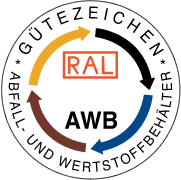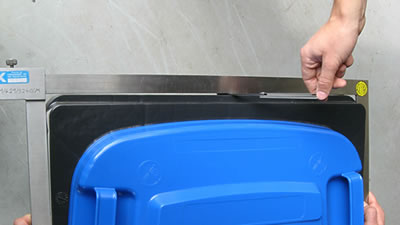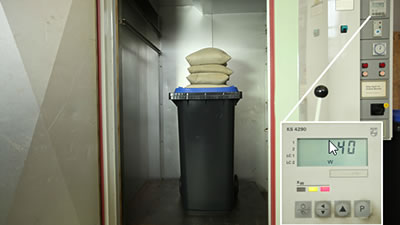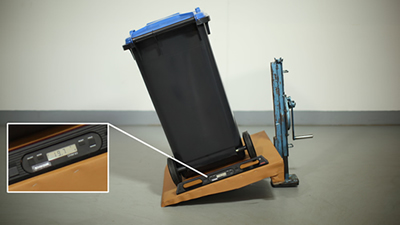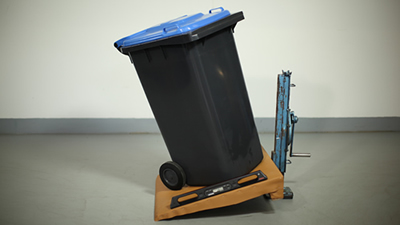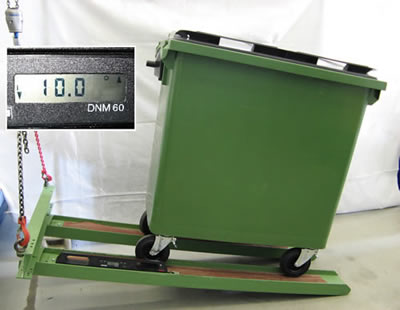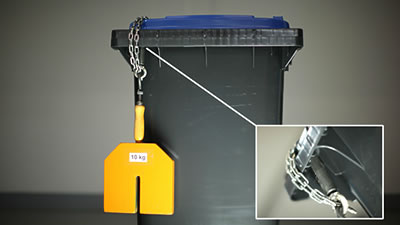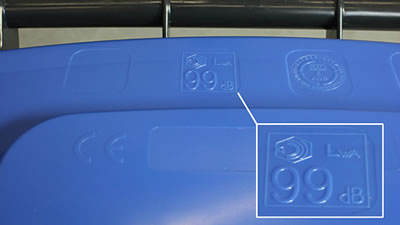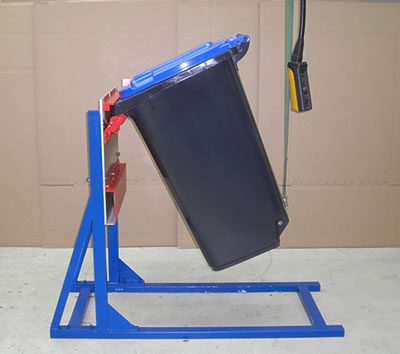Test temperature:
15 °C
Test specifications:
In order to determine the volume of a container, the container body and the lid are separately filled with water. The excess volumes from the wide top edge of the container body must be subtracted from the total volume. The measurement process is carried out using external pressure equalization. The volume of dome lids may also be calculated.
Reason for testing:
Guaranteed conformity to standard
Test temperature:
70 °C
Test procedure:
A 2-wheeled waste and recycling container is totally immersed in a wetting agent bath and with regard to 4-wheeled waste and recycling containers, specially defined sections may also be used. The sections remain immersed in the bath for 48 hours and are subsequently rinsed off with water.
Evaluation criteria:
There shall not be any visible flaws/cracks on critical sections e.g. the frontal receiver. This visual test is carried out 6 hours after the container/parts have been removed from the bath.
Reason for testing:
Possible manufacturing errors e.g. flake cracks become visible by means of this test.
Test temperature:
-18 °C for the first test (12 hours pre-cooling)
23 °C during monitoring
Test load:
0.4 kg /dm3 x nominal volume, e.g. 96 kg for waste and recycling container (AWB) 240
Test procedure:
A 2-wheeled waste and recycling container is filled with the test load and then dropped a total of 4 times from a height of 3 meters (3 x flat bottom landing, 1 x tilted body; bottom front edge landing). The 4-wheeled waste and recycling container is dropped for a flat landing from a height of 2.5 meters.
Evaluation criteria:
No cracks on the body shall occur that would influence container usability.
Reason for testing:
Tests are carried out to check the stability of the container’s design and construction and the production processes.
Test temperature:
-18 °C for the first test (12 hours pre-cooling)
Test procedure:
A steel pin weighing 5 kg is dropped on all of the susceptible points of a container’s body from a height of 1.0 meters and onto the lid from a height of 0.8 meters. Each testing point on the bottom of the body is tested three times and all other points are tested twice.
Evaluation criteria:
The waste and recycling container must be water tight at all of the points tested and no cracks shall occur.
Reason for testing:
Guaranteeing usability
Test temperature:
23 °C
Test load:
0,4 kg/dm3 x nominal volume
E.g. 440 kg for waste and recycling container (AWB) 1100
Test procedure:
The waste and recycling container that is filled with a test load is tilted for emptying 100 times using a standardized lifting device according to EN 1501. The container is not emptied; instead the test load remains in the container during the entire testing period.
Evaluation criteria:
There shall be no visible damage.
Reason for testing:
The functionality of the waste and recycling container during emptying must be unconditionally guaranteed.
Test temperature:
23 °C
Test load: 0,4 kg/dm3 x nominal volume E.g. 440 kg for waste and recycling container (AWB) 1100
Test procedure:
The waste and recycling container, including its test load, impacts with a 140 mm high kerb from different positions 8 times.
Evaluation criteria:
There shall be no permanent deformities and no breakage that affect usability.
Reason for testing:
The driving and coupled axels or so-called “travelling gear” must withstand the requirements.
Test temperature:
23 °C
Test load:
For 2-wheeled waste and recycling containers: 40 kg
For 4-wheeled waste and recycling containers: 65 kg
Test procedure:
A wheel is tested on a circular track and rolled over an 11.5 cm high obstacle at a predetermined speed. One revolution of the track is 3.5 metres. This test is carried out using a predetermined cycle sequence of movement and stoppage. The total length of the test is 5 kilometres for 2-wheeled containers and 20 kilometres for 4-wheeled containers.
Evaluation criteria:
There shall be no permanent deformities or breakage after the test has been carried out that would affect the tilting and rolling of the container.
Reason for test:
This test is a simulation of the functional characteristics of wheels during which they roll along a certain track and roll over an obstacle, e.g. simulation of going over a kerb.
Test temperature:
23 °C
Test load:
0.4 kg/dm3 x nominal capacity
E.g. 440 kg for waste and recycling container (AWB) 1100
Test procedure:
The waste and recycling container, including its test load, impacts with a stationary wall at a defined speed from different positions 16 times
Evaluation criteria:
Deformities are allowed, however the waste and recycling container must remain functional.
Reason for testing:
Guaranteeing the stability of the container’s body and lid.
Test temperatur:
23 °C
Test load:
0.4 kg/dm3 x nominal volume
E.g. 96 kg for waste and recycling container (AWB) 240
Test procedure:
The waste and recycling container, including its test load, is dropped on its wheels 1,000 times from a height of 200 mm.
Evaluation criteria:
There shall be no permanent deformities and no breakage that affect usability
Reason for testing:
This test is a simulation of the requirements of every day use concerning running over kerbs.
Test temperature:
23 °C
Test load:
0.4 kg/dm3 x nominal volume
E.g. 96 kg for waste and recycling container (AWB) 240
Test procedure:
The waste and recycling container, including its test load is pulled at a predetermined speed over a 3 metre test track. The pulling force and the tractive force necessary to keep the container in continual motion are measured.
Test criteria:
The tractive force shall not exceed 300N.
The maximum allowed motive force is:
2-wheeled waste and recycling containers: 60 N
4-wheeled waste and recycling containers: 285 N
Reason for testing:
Guaranteeing easy waste and recycling container handling.
Test temperature:
23 °C
Test procedure:
A defined test dummy (equivalent to a 10 year old child) is stood up on a box and positioned leaning over the front rim of the open waste and recycling container. The lid is closed over the test dummy and the box is then pulled away from the container. The test is carried out with the test dummy leaning over the front of the container as well as over both sides. The test is carried out 5 times in each position.
Evaluation criteria:
The test dummy must fall out of the container after a maximum of 2 seconds for each test phase.
Reason for testing:
Accident prevention
Test temperature:
23 °C
Test procedure:
The horizontal deformation of the front receiver is measured where the gap is the greatest (see photograph).
Evaluation criteria:
The value for 2-wheeled waste and recycling containers shall not exceed 1% and 0.7% for 4-wheeled waste and recycling containers of the length of the front receiver.
Reason for test:
Guaranteeing the proper receipt of the waste and recycling container by the lifting device.
Test temperature:
40 °C
Test procedure:
The middle of the lid is weighted (area: 25 x 25 cm) with 400 N and placed in an oven at the prescribed test temperature for 4 hours.
Evaluation criteria:
The lid shall not retract into the container during testing and must have, to the greatest possible extent, returned to its original state within 24 hours after testing has been completed.
Reason for test:
Checking the stability of the lid.
Test temperatur:
23 °C
Test load:
0.4 kg/dm3 x nominal capacity
E.g. 96 kg for waste and recycling container (AWB) 240
Test procedure:
The testing device is tilted to 12°. The waste and recycling container must be tested in 3 different positions, i.e. back/front, side and diagonally. All of the tests are carried out on both empty and full containers.
Evaluation criteria:
The waste and recycling container must not move or tip over.
Reason for test:
Guaranteeing the stability of the waste and recycling container.
Test temperature:
23 °C
Test load:
0.4 kg/dm3 x nominal capacity
E.g. 440 kg for waste and recycling container (AWB) 1100
Test procedure:
The testing device is tilted to 10°. The brakes of the waste and recycling container are set and the container must remain stationary for 60 seconds.
Evaluation criteria:
The waste and recycling container must remain stationary.
Reason for the test:
Guaranteeing the effective breaking of the waste and recycling container on an incline too.
Test temperature:
23 °C
Test procedure:
The testing device that is weighted with 10 kg is pushed into the chip nest of the waste and recycling container and left for one hour. The testing device must be used not less than 24 hours after the container has been manufactured and the test must be carried out at least 24 hours after the device is fitted.
Evaluation criteria:
The testing device shall not fall out of the chip nest during the test.
Reason for test:
The transponder shall not fall our of the chip nest during the operational life of the waste and recycling container.
Test procedure:
Visual inspection of all required marks and labels:
Body:
Mould number, date of manufacture (year and month), standard (EN 840 and/or DIN 30760), nominal volume, maximum allowed total mass, manufacturer’s name or a registered trade name, RAL-Quality Mark.
Lid:
Mould number, date of manufacture (year and month), noise emission mark according to 2000/14/EG, RAL-Quality Mark.
Evaluation criteria:
Affixed markings and labelling must be clearly visible and indelible.
Reason for test:
Regulation according to RAL-GZ 951/1 and EN 840 as well as the European guideline 2000/14/EG.
Test temperature:
-18 °C
Test procedure :
The waste and recycling container is connected to the frontal receiver of the testing device. It is then raised to 25° angle and left hanging in this position for 5 seconds.
Evaluation criteria :
The waste and recycling container shall not have any cracks or stress whitening.
Reason for the test :
According to the European Tipping Standard EN 1501-5, the movement of the waste and recycling container of about 25° during emptying is allowed. The test assures that the waste and recycling container is designed and constructed for these operational demands.
